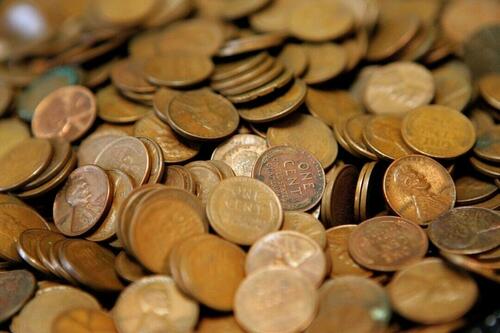
Say Goodbye To The Penny
Authored by Jeffrey Tucker via The Epoch Times,
The U.S. Mint will stop making the penny next year. The reasons are purely practical. It costs three times as much to make as it is worth. Dropping it will save $56 million. Most people don’t carry them anyway; the bulk of the existing stock is thrown out or put in jars at home.
Presidents have urged this for many years, but the time has finally come. Many people will be relieved. Someone gave me pennies in change just the other day. All I could think was that they were taking up space in my pocket for no reason.

Good riddance.
However, the legacy of the penny will last in our language. We will still ask a penny for thoughts. We will still throw in our 2 cents in discussions. A penny saved will even be a penny earned. We can still be penny-wise and pound-foolish. In tight times, we will still pinch pennies.
But pricing will likely shift. The old psychological trick of pricing things at 99 cents will persist. I saw a bag of chips the other day marked at $11.99. The memorable part is the 11, not the masked 12. That habit will likely go away. Even though only one in five transactions are in cash, it is likely that pricing habits will adapt in time.
However, aside from all these seeming trivialities, there is a gravely serious matter here. What it ultimately reveals is the monetary system’s mass theft of the public’s wealth. Here’s why.
Back in 1913, if you had 3 cents, you had the spending power that you would have if you had a dollar today. That’s a 33-fold increase in prices over a century and a decade of central banking and money printing to sustain an ever larger government and an ever bigger debt burden.
The loss of purchasing power in the money is the equivalent of a tax, a sneaky, surreptitious tax that masks its coercion in monetary depreciation.
By the way, I’m pretty sure that these numbers don’t capture the whole of it. They are drawn from the Consumer Price Index (CPI). I no longer trust it.
Memorial Day weekend reminds me why. Did you get out and about and look at the prices at the stores? They are simply astonishing. The world around us has fundamentally changed in five years.
I saw jeans for $200, a blazer for $1,500, cheap beef for $7, and bar burgers for $48 that looked affordable compared with everything else on the menu. I was thrilled for a $12 beer, which I thought was a bargain until I remembered that this would have been $6 only five years ago.
There is no number that can precisely measure how much prices have risen in five years. It is a good rule of thumb to add one-third to the sticker price of most things. This is more than the 23 percent that the CPI claims. But even as you read that, I know you are thinking of goods and services that have gone up far more, by 50 percent or even 100 percent in price.
It’s a completely different world out there now. I know I’m not adjusting well. My memory of prices just five years ago makes me feel like a dinosaur from a different age. I get the impression that I’m constantly being ripped off, even though it is not the sellers’ fault. The robbery is more subtle. It makes me not want to buy anything.
I cannot even imagine what it must be like for someone in their 20s of moderate income. It must feel like there is no way they will ever get ahead. They are lucky if they have parents who can flip them a few thousand dollars from time to time to help them get by. If not, they go into debt.
My phone and email light up constantly with offers to split payments, buy on credit, get a cash advance, try a new app that links directly to my bank, and so on—huge and growing businesses all built on the insolvency of average people. People use them out of desperation. They offer a temporary means of survival. They are not a solution. They are temporary palliatives that make matters worse.
This is the bigger picture and why we simply cannot treat the end of the penny as a trivial matter. It signals something terrible: the weaponization of the monetary system as a means of enriching elites and impoverishing the masses. It is a prescient symbol of deep and abiding suffering.
What is being done about it? Nothing really. The Supreme Court issued an opinion last week (Trump v. Wilcox) that was very strange. It said the president can fire the heads of any executive agency (he clearly can, according to the Constitution). Good. But then the court added a baseless carve-out.
The court said it disagrees with arguments that the decision “necessarily [implicates] the constitutionality of for-cause removal protections for members of the Federal Reserve’s Board of Governors or other members of the Federal Open Market Committee.” The opinion describes the Fed as “a uniquely structured, quasi-private entity that follows in the distinct historical tradition of the First and Second Banks of the United States.”
Wait, that’s it? The Fed is “uniquely structured” and that’s why the president cannot fire its head? Note that the First Bank and Second Bank were sources of huge controversy in the nation. Both were abolished as terrible threats to liberty. These were national banks for the government alone. The Fed is far worse: a central bank for the entire system and the whole nation.
This decision alone reveals that the court is not particularly serious about the Constitution as a whole. It picks and chooses whatever it wants from it. There is obviously nothing in that document that permits a central bank. Quite the reverse: The Framers even required that only gold and silver be minted as money and banned paper issuance by the states.
Would that such strictures had stuck throughout U.S. history. In a true market system of money based on sound principles, with rising productivity, we have every reason to expect that purchasing power would rise over time, as it did in the age of the old gold standard.
If someone asked me today what to do about it, I would falter at the precise answer. I don’t have a plan to offer to restore the gold standard of old, and every plan that I’ve seen has embedded problems. That said, there is plenty that can be done to at least get us back on the right track.
Balance the budget. Stop the debt creation. Rein in the Fed’s powers to print. If we could at least get that much done, we could have a conversation about the next steps—but we aren’t even close to that.
At the outset of the Trump administration, I was optimistic that the Department of Government Efficiency would make a big difference. Yes, I trusted the rhetoric, even if all experience suggested that I should not. Sure enough, a Republican-controlled Congress has pushed through a bill that pretty much ignores all the cost savings found by Elon Musk and his team. Disgusted, Musk has lost interest in politics and gone back to building a great fortune.
This is a sad moment in some ways. It is possible that we will never see another opportunity like that in our lifetimes.
Meanwhile, I made the mistake of looking at real-time prices just now. They are rising again after having fallen precipitously after the inauguration. They are again above 2 percent per year. And the money supply—already up by $6.5 trillion from what it was five years ago—is rising again and just barely short of matching its previous height of April 2022.
Is this the tariffs starting to bite? They are contributing, no question. It is also possible that suppliers are using tariffs as a means of excusing delayed price increases from previous inflation. Regardless, we are starting to see signs of a second wave of inflation. I cannot fathom how we can endure such a thing.
I truly wish that this were a new Golden Age. There are many good trends, no question. But the fundamentals related to fiscal and monetary policy are still cracked and decaying. That worries me. Even more troubling, the system seems impenetrable to repair, even under the heavy hand of President Donald Trump.
That’s my 2 cents. Penny for your thoughts?
Views expressed in this article are opinions of the author and do not necessarily reflect the views of The Epoch Times or ZeroHedge.
Tyler Durden
Wed, 05/28/2025 – 15:50














